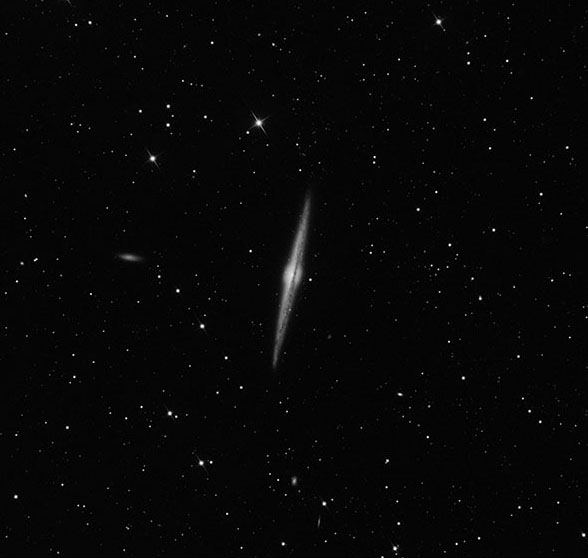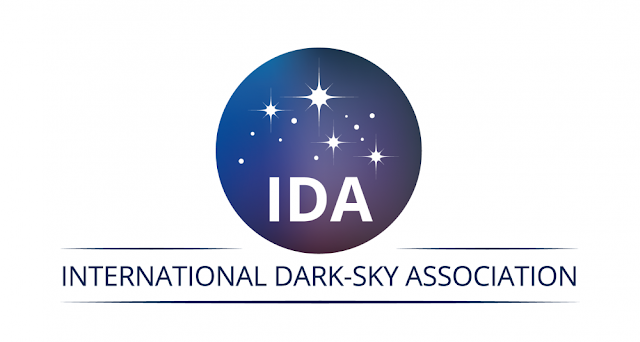 |
| Comet C/2019 Y4 (ATLAS) Imaged on ATEO-1 by Muir Evenden as it makes its way thru the constellation Camelopardalis on March 30, 2020. |
Comet ATLAS
C/2019 Y4 (ATLAS) was discovered by the ATLAS comet survey in December 2019 but grabbed the observer's attention when it dramatically surged in brightness in January 2020. So far the comet has reached a magnitude of approximately 8.0, and it's predicted that in April it might get bright enough to see with the naked eye. The comet is located in the constellation Camelopardalis throughout April and is placed well for Northern hemisphere observers during April nights. Grab a telescope or some binoculars to observe the comet, or if it gets bright enough try observing without equipment!
International Dark-Sky Week
Sunday, April 19th through Sunday, April 26th, celebrate International Dark Sky Week by keeping your outdoor lights turned off after sunset to reduce light pollution. Endorsed by the International Dark-Sky Association and the American Astronomical Society, International Dark Sky Week presents an opportunity to appreciate the beautiful night sky without the adverse effects of light pollution from outdoor lighting. Turn out those lights and enjoy views of the starry sky from your own backyard! Find out more at https://www.darksky.org/dark-sky-week-2020/.
 |
| NGC 4565 Galaxy in Virgo was imaged on ATEO-1 by Muir Evenden back in 2018. |
Spring Brings Galaxy Season
April skies provide stargazers with ample opportunities to observe far-off galaxies. With the Virgo Galaxy Cluster and bright galaxies in the Big Dipper and Coma Berenices well-positioned in the sky, April evenings are truly a gift for galaxy hounds. Check out a few of our favorite galaxies: M101, M51, and M106 near the Big Dipper asterism; M86, M87, M84, and M104 in the Virgo Galaxy Cluster; and don't miss NGC 4565, M64, M99, and M100 in the constellation Coma Berenices. While a humble 80mm telescope will show most of the galaxies we mention, a big reflector like our SkyQuest XT10 Classic Dobsonian will provide jaw-dropping views of these distant beauties!
New Moon, Dark Skies
Take advantage of the dark skies provided by the New Moon on April 22nd to scope out the many star clusters, galaxies, and other deep-sky gems April has to offer. Bundle up, grab a telescope and your astrophotography gear and get out there to view and image those elusive fainter deep sky objects.
Lyrids Meteor Shower
Get outside after midnight on the night of April 16th to enjoy the start of the Lyrids Meteor Shower. Look for meteors to radiate outwards from the constellation Lyra at the peak of the shower, after midnight on the 21st into the early hours of April 22nd. The Lyrids is a medium shower, which should produce about 18 per hour this year. The peak is close to the new moon, presenting almost no interference. The Lyrids shower often produces meteors with impressive dust trails that can last several seconds. You don't need a telescope to enjoy the show — just sit back in a comfy chair and watch bright dust trails flare across the sky. More information is available at https://www.amsmeteors.org/meteor-showers/meteor-shower-calendar/#Lyrids.
April's Deep-Sky Challenge: M87 in the Virgo Galaxy Cluster
This is a great challenge for experienced observers. It's been said that the jet of light, famous in photographs, emanating from the core of M87 can be observed visually in telescopes possibly as small as 10" from a dark sky location, on the clearest of nights.
If you're up for the challenge, try to view M87 as high in the sky as possible, and use as much magnification as the conditions permit. Look for a short streak of light emanating from the core, slightly brighter than the surrounding haze. The key to this challenge is finding the right viewing condition. When trying on different nights, note the visibility of the stellar core — this is a good indicator of the quality of the night and the suitability of a particular eyepiece. A Barlow like the Orion Shorty 1.25" 2x Barlow Lens and an eyepiece such as the 15mm Orion Expanse Telescope Eyepiece provide a good starting point for viewing.
With some patience and a dark, clear night, you may just find Virgo's hidden treasure. Good luck and clear skies!
This challenge is adapted from "Focus on Downtown Virgo" by Observing Skyhound at Skyhound.com.
All objects described above can easily be seen with the suggested equipment from a dark sky site, a viewing location some distance away from city lights where light pollution and when bright moonlight does not overpower the stars.


No comments:
Post a Comment